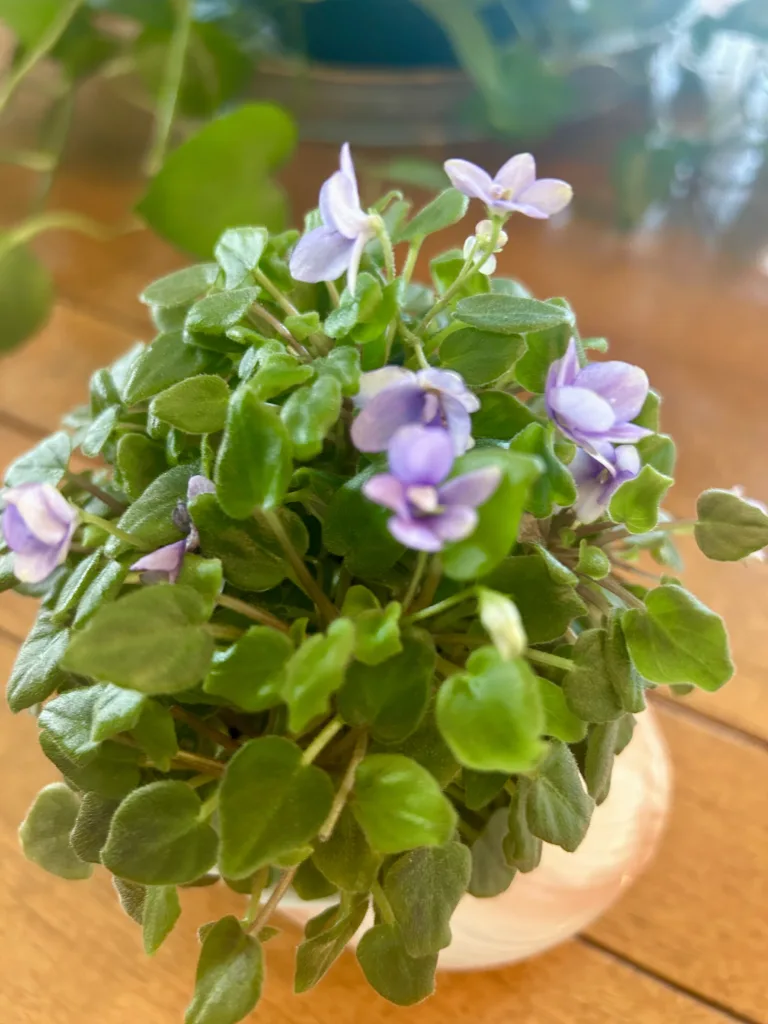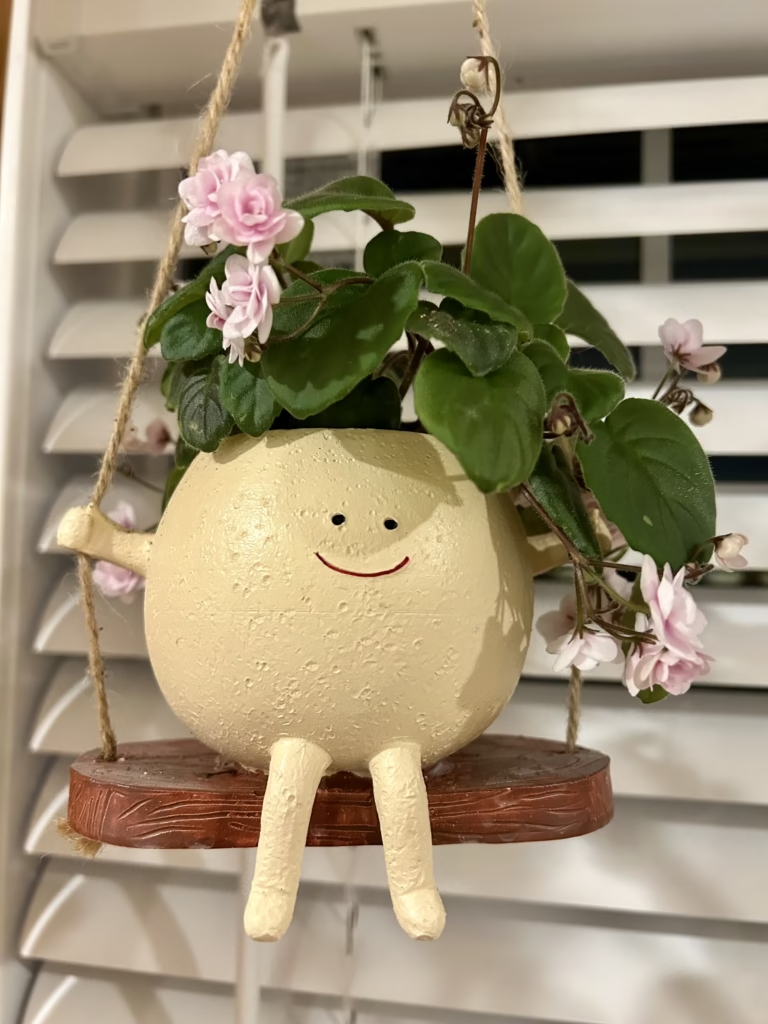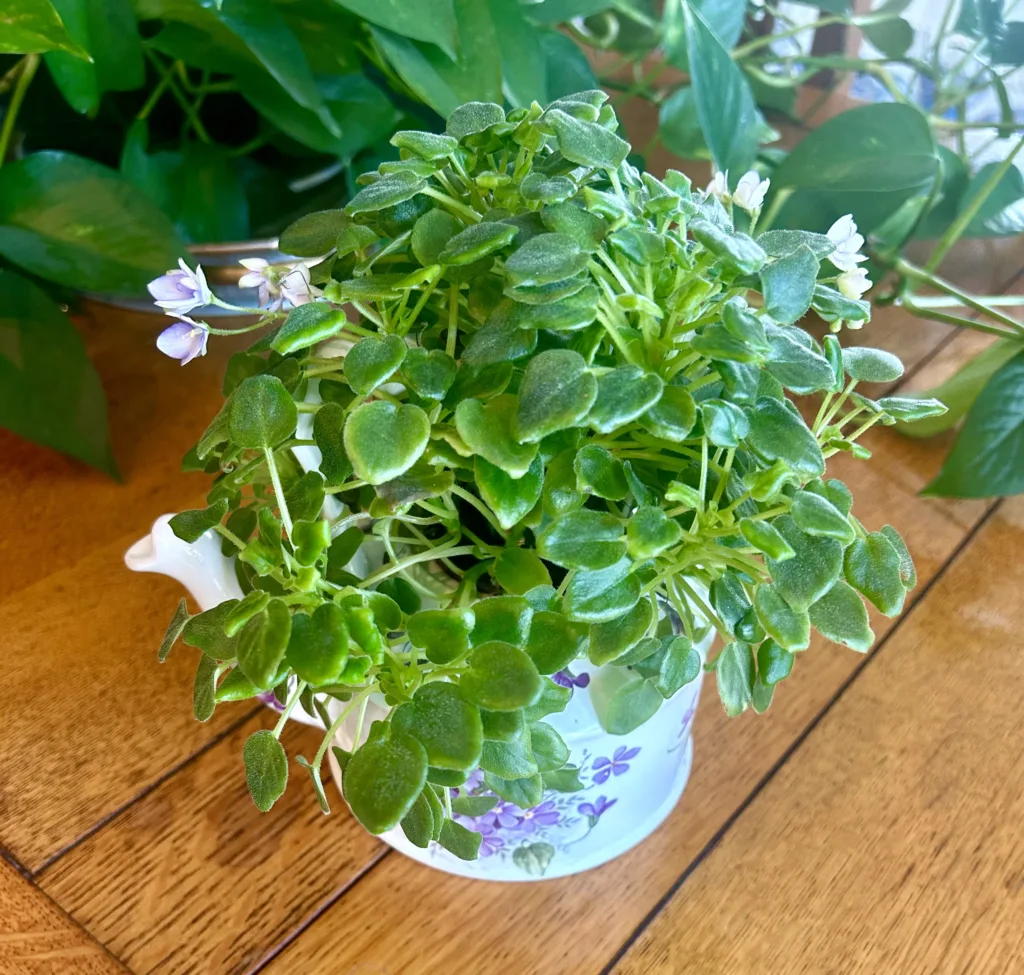
African Violet trailers are a charming and unique variety of African Violets known for their trailing growth habit. Unlike standard African Violets, trailers send out multiple crowns and naturally sprawl over the edge of their pots, creating a full, cascading effect. These trailing varieties are ideal for hanging baskets or shallow wide pots where their beauty can be fully displayed. With the right pot, soil, water, light, and fertilizer, African Violet trailers thrive indoors and reward you with frequent blooms. This guide will show you how to care for these lovely plants and keep them flourishing.
Choose the Right Pot for African Violet Trailers
Selecting the right pot is the first step to growing a healthy African Violet trailer. Since these plants develop multiple crowns and grow outward rather than upward, a shallow and wide pot works best. Choose a container that is about 4 to 6 inches wide and no deeper than 3 inches. This shape gives the plant room to spread while preventing overly wet soil at the base, which can lead to root rot.

If you’re planting a more mature trailer with established growth, go slightly wider to allow extra space for development. Hanging baskets, or even hanging pot face planters like mine pictured here, ceramic dish planters, or wide shallow bowls work well. Make sure the pot has drainage holes to prevent soggy soil. You can also place your pot in a decorative outer cache pot without holes, but always make sure excess water can drain and does not stay pooled at the bottom.
Use the Best Soil for Trailing African Violets
African Violet trailers need light, airy soil that drains well while still holding some moisture. Avoid using standard garden soil or heavy potting mixes, as these compact around the roots and can suffocate them. Instead, choose a commercial African Violet soil mix, or make your own blend using equal parts peat moss and perlite.
Adding a bit of vermiculite can help retain moisture without becoming soggy. Avoid any soil that contains bark or large chunks, as trailers prefer fine-textured soil that supports their delicate roots. Always moisten the soil slightly before potting, and make sure it feels springy and light when pressed.
Watering African Violet Trailers the Right Way
Watering is one of the most important aspects of African Violet trailer care. These plants dislike soggy roots and cold water but thrive with consistent moisture. You can choose from three methods: bottom watering, top watering, or water wicking.
Bottom watering is ideal because it keeps moisture away from the leaves and base of the plant. Place the pot in a shallow dish of lukewarm water and allow it to absorb moisture for about 30 minutes. Then remove the pot and let it drain completely.
Water wicking is a great option if you want to automate watering. Use a wick made from cotton or acrylic yarn and thread it through the bottom of the pot. Place the other end in a container of water. The wick will slowly draw water up into the soil, keeping it evenly moist.
Top watering can work, but be careful not to splash water on the leaves or crowns. Always use room-temperature water and pour gently around the edge of the pot. Let the pot drain completely and never let it sit in standing water.
No matter which method you choose, let the soil dry slightly between waterings. Stick your finger about half an inch into the soil. If it feels dry, it’s time to water. Overwatering leads to crown rot, while underwatering can cause wilting and poor blooming.
Provide the Right Light for Healthy Growth
Light is essential for African Violet trailers to bloom and grow strong. These plants need bright, indirect light to thrive. A north- or east-facing window usually works well, or you can place them near a south- or west-facing window with sheer curtains to filter the sunlight.
If natural light is limited, use grow lights for 12 to 14 hours per day. LED grow lights are energy-efficient and provide the full spectrum of light your plants need. Keep the lights about 10 to 12 inches above the plants to avoid scorching the leaves.
Too little light results in leggy growth and few blooms. On the other hand, too much direct sun can scorch leaves and stunt growth. Look for signs like pale leaves, crispy edges, or no flowers to help you adjust the light level.
Fertilize African Violet Trailers for Lush Blooms
Fertilizing African Violet trailers helps maintain lush growth and frequent blooming. Use a balanced fertilizer formulated for African Violets, such as Schultz African Violet fertilizer to encourage more flowers.
Liquid fertilizer works best and should be diluted to one-quarter to one-half strength. Feed your trailers every two to four weeks during the growing season. If you are using a wick watering system, you can add fertilizer to the water reservoir at a weaker concentration and fertilize consistently that way.
Watch for signs of over-fertilization, such as leaf tip burn, salt build-up on the soil, or poor flowering. In those cases, flush the soil with plain water to remove excess salts and let the plant rest for a couple of weeks before feeding again.
Propagating African Violet Trailers
Propagating African Violet trailers is easy and rewarding. You can start new plants using leaf cuttings, sucker crowns, or even broken trailing stems. If your trailer is overgrown or leggy, propagation is a great way to rejuvenate your plant.
To propagate from a leaf cutting, choose a healthy, mature leaf with a short stem. Cut the stem to about 1 to 1.5 inches long and insert it into moist soil or place it in water until roots form. In soil, cover the pot loosely with a plastic bag to create humidity and place it in bright, indirect light. Within a few weeks, small plantlets will begin to appear.
To propagate using a crown or sucker, gently separate a small growing crown from the main plant using a sterile blade. Pot the new crown in fresh soil and treat it like a mature African Violet. Keep it moist and warm until roots establish.
You can also root trailing stems, especially if one breaks off while repotting. Trim the stem to about 2–3 inches, remove lower leaves, and plant it horizontally in moist soil. This method often produces multiple crowns, which can grow into a beautiful new trailing plant.
Tips for Keeping African Violet Trailers Happy
To keep your African Violet trailers healthy, always remove spent flowers and any yellowing leaves. This encourages fresh growth and prevents disease. Rotate the pot every week or two to promote even growth on all sides, especially if using natural light.
Repot every 6 to 12 months to refresh the soil and allow room for new crowns to form. Use the same wide and shallow pot style, and trim away any damaged roots. When repotting, gently fan out the crowns to give them space to grow.
Humidity also helps. African Violet trailers prefer 50% humidity or higher. If your home is dry, place a shallow tray of water near the plant, or group it with other houseplants to boost humidity. Avoid misting, as this can cause water spots on leaves. This hygrometer is perfect for monitoring humidity levels.
Final Thoughts on African Violet Trailers
African Violet trailers are a beautiful and rewarding type of African Violet that adds cascading charm to your indoor garden. With the right pot size, well-draining soil, proper watering method, consistent light, and regular feeding, these plants will thrive and bloom generously throughout the year. Whether you’re displaying them on a windowsill, a plant shelf, or in a hanging basket, their trailing growth and soft blooms bring elegance and color to any space. By learning how to propagate and care for them properly, you can enjoy African Violet trailers for years to come.
Please be sure to check out my Gardening Blog Post Page for more tips on all types of gardening. Including Seed Saving, Seed Starting, Orchids, Water Gardening, Coldframe Gardening, Indoor Bulb Gardening, Hydroponics, Container Gardening, Mums, Herbs, African Violets, planting Bulbs, Flower Gardening, Vegetable and Fruit Gardening, Indoor Houseplants of all kinds, Bonsai, Cactus, Succulents, Hanging plants, Deer resistant plants and even Bird, Bee, Butterfly and Hummingbird Gardens!

